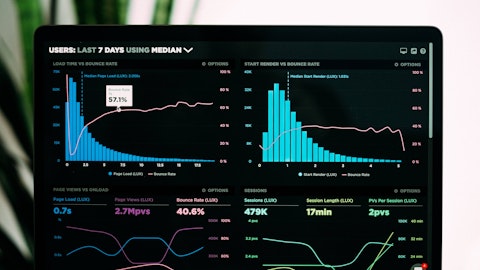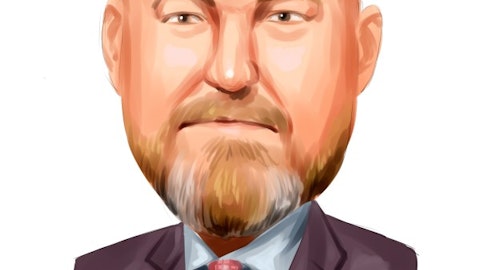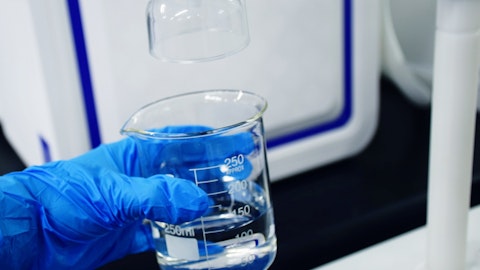Quest Diagnostics Incorporated (NYSE:DGX) Q4 2022 Earnings Call Transcript February 2, 2023
Operator: Welcome to the Quest Diagnostics Fourth Quarter and Full Year 2002 conference call. At the request of the company, this call is being recorded. The entire contents of the call, including the presentation and question and answer session that will follow are copyrighted property of Quest Diagnostics with all rights reserved. Any redistribution of retransmission of the rebroadcast of this call in any form without the written consent of Quest Diagnostics is strictly prohibited. Now I’d like to introduce Shawn Bevec, Vice President, Investor Relations for Quest Diagnostics. Please go ahead.
Shawn Bevec: Thank you and good morning. I’m joined by Jim Davis, our Chief Executive Officer and President, and Sam Samad, our Chief Financial Officer. During this call, we may make forward-looking statements and will discuss non-GAAP measures. We provide a reconciliation of non-GAAP measures to comparable GAAP measures in the tables to our earnings press release. Actual results may differ materially from those projected. Risks and uncertainties, including the impact of the COVID-19 pandemic, that may affect Quest Diagnostics’ future results include but are not limited to those described in our most recent annual report on Form 10-K and subsequently filed quarterly reports on Form 10-Q and current reports on Form 8-K. For this call, references to reported EPS refer to reported diluted EPS, and references to adjusted EPS refer to adjusted diluted EPS.
Any references to base business, testing, revenues or volumes refer to the performance of our business excluding COVID-19 testing. Growth rates associated with our long term outlook projections, including total revenue growth, revenue growth from acquisitions, organic revenue growth, and adjusted earnings growth are compound annual growth rates. Finally, revenue growth rates from acquisitions will be measured against our base business. Now here is Jim Davis.
Jim Davis: Thanks Shawn, and good morning everyone. Quest had a strong year in 2022 with base business revenues growing more than 6% in the fourth quarter and 5% for the full year. As we expected COVID-19 testing revenues declined but still exceeded $1.4 billion in 2022. Our strong performance over the last several years would not have been possible without the commitment and compassion of our nearly 50,000 colleagues who rose to the challenge of COVID-19 while growing our base business. I am incredibly proud of how this team has worked together during an unprecedented period in the lab industry to deliver insights to help create a healthier world. This morning, I’ll discuss our performance for the fourth quarter and full year 2022, then Sam will provide more detail on our financial results and discuss our 2023 guidance.
In the fourth quarter, total revenues were $2.3 billion, earnings per share were $0.87 on a reported basis and $1.98 on an adjusted basis, cash from operations was $334 million. For the full year 2022, total revenues were $9.9 billion, including more than $8.4 billion in base business revenue. Earnings per share were $7.97 on a reported basis and $9.95 on an adjusted basis. Cash from operations was $1.7 billion. As you saw this morning, we increased our quarterly dividend approximately 8% to $0.71 per share and increased our share repurchase authorization by $1 billion. Before discussing additional highlights for 2022, I’d like to share some recent positive regulatory updates. First, Congress delayed Medicare reimbursement cuts under PAMA that were scheduled to take place in 2023, which would have impacted our revenue between approximately $80 million and $85 million.
While we are pleased with the delay, we continue to work closely with our trade association to seek a permanent fix to PAMA. Second, CMS increased Medicare reimbursement for specimen collection fees for the first time in nearly 40 years. This could provide Quest with a benefit of approximately $35 million to $40 million this year. Regarding COVID-19 testing revenues, while we did see a steady ramp upward in COVID-19 volumes throughout Q4, our volumes have steadily declined since late December. We expect our COVID-19 revenues to be significantly lower in 2023 compared to 2022. We have lowered our prior COVID-19 volume expectations in 2023 from 10,000 to 15,000 molecular tests per day to 5,000 to 10,000 tests per day. In addition, we continue to negotiate coverage and reimbursement policies with commercial payors following the end of the PHE in May.
I will now share some recent highlights in how we are growing this business. In the fourth quarter, we completed our acquisition of the outreach laboratory services business of Suma Health, a large integrated health system serving communities in northeastern Ohio. We also entered into an agreement to acquire select assets of Northern Light Health’s outreach laboratory services business located in Maine. We will also provide professional laboratory management services for nine of Northern Light’s hospital laboratories along with its cancer center lab. Our M&A pipeline is strong, including potential deals with health systems, small regional labs, and other capability-building assets. In particular, the funnel of opportunities with health systems, which are facing major margin pressures due to labor challenges and mix shift from inpatient to outpatient care, is very active.
Quest can help through lab management, population health analytics, mobile services, and/or by monetizing their outreach business. In health plans, we continue to gain traction with value-based contracts where we see meaningfully higher growth than with traditional contracts. Also, we’ve started to benefit from incentives related to these value-based contracts which helps demonstrate the value of these strategic relationships. With CMS’ recent increase in Medicare reimbursement for specimen collections, we’ve begun discussions with our health plan customers about getting paid appropriately for the phlebotomy services we provide to their members. Higher specimen collection fees enable us to make continuous investment in patient services so their members continue to have the broadest access to high quality and low cost lab testing.
In advanced diagnostics, we generated strong double-digit growth in prenatal genetics and pharma services in 2022. In 2022, we also launched a solid tumor expanded panel as a laboratory-developed test. This 523 gene test relies upon the Illumina TruSight Oncology 500 assay to help oncologists with therapy selection by providing comprehensive genomic profiling of a patient’s tumor. This test extends our capabilities beyond tissue pathology to offer faster turnaround time from cancer diagnosis to therapy selection. Throughout 2022, we continued to make investments to strengthen our bio-informatics capabilities which support some of the faster growing opportunities of our portfolio, like genomic sequencing services, prenatal and hereditary genetic testing, and pharma services.
We also invested in our women’s health sales force which will position us well for continued strong growth in prenatal genetics. We continue to make progress executing our consumer initiated testing strategy. Last year, we recorded approximately $96 million of both base and COVID-19 consumer testing. In the fall of 2022, we launched our new digital platform, QuestHealth.com. Consumers have found this to be a simpler, more intuitive way to order lab tests. Following the launch of our new consumer sight, we began ramping up marketing spend through the fourth quarter. We saw some of the strongest order volumes to date following some Cyber Monday promotional advertising, and we are encouraged by the acceleration of growth in base testing in December.
Shifting to operational excellence, in 2022 we approached our goal of 3% productivity improvements and savings through our Invigorate program. Those savings and productivity improvements did not completely offset the inflationary pressures in our business, as well as the impact of a modest unit price decline. Following the pandemic, we like many companies have faced significant inflation and wage pressures. We are increasing our efforts to drive productivity and expand margins in our base business. We continue to drive additional productivity improvements with lab platform consolidation and greater use of automation and artificial intelligence. Last year, we began a new automation conversion project in our Lenexa laboratory. This new project builds on what work we’ve done in our Marlborough and Clifton labs.
We’ve introduced a new microbiology platform that is highly automated and makes use of artificial intelligence to assist with sample analysis. Finally, we’ve begun to realize savings from the urinalysis platform conversion that we announced early last year. Filling and retaining our frontline positions continues to be a key priority for us. Although we have experienced higher than average turnover in some of our job categories, we have taken actions to stabilize our workforce and improve frontline employee engagement and retention. We expect these actions to help enhance our productivity in 2023. We have also taken actions to reduce our SG&A by approximately $100 million in 2023, including workforce reductions of approximately 1.5% primarily in corporate support functions.
With that, I’ll turn it over to Sam to provide more details on our performance and our 2023 guidance. Sam?

Sam Samad: Thanks Jim. In the fourth quarter, consolidated revenues were $2.33 billion, down 15% versus the prior year. Base business revenues grew 6.3% to $2.15 billion while COVID-19 testing revenues declined 75% to $184 million. Revenues for diagnostic information services declined 15.3% compared to the prior year, reflecting lower revenue from COVID-19 testing services versus the fourth quarter of 2021, partially offset by strong growth in our base testing revenue. Total volume measured by the number of requisitions declined 11.2% versus the fourth quarter of 2021 with acquisitions contributing 20 basis points to total volume. For the quarter, total base testing volumes declined 0.6% versus the prior year. The year-over-year decline was primarily related to lower employer drug testing volume and adverse weather events during the quarter, which together represented a volume headwind of more than 1.5%.
COVID-19 testing volumes contributed to the decline during the fourth quarter. We resulted approximately 1.9 molecular tests in the quarter. This was down 1.2 million tests versus the third quarter and down approximately 5.4 million tests versus Q4 of 2021. After rising modestly throughout the fourth quarter, our COVID-19 molecular volumes declined to an average of roughly 17,000 tests per day in January and currently make up less than 3% of our daily volumes. In the fourth quarter, revenue per requisition declined 5.1% versus the prior year, driven primarily by lower COVID-19 molecular volume. Base business revenue per req was up 6.8%. This strong increase in revenue per req was driven by a number of factors, including test and payor mix, the more favorable pricing environment with health plans, including incentives under our value-based contracts, and lower patient concessions.
Unit price reimbursement pressure remained consistent with our expectations at approximately 50 basis points in the quarter. Reported operating income in the fourth quarter was $135 million or 5.8% of revenues compared to $536 million or 19.5% of revenues last year. On an adjusted basis, operating income was $330 million or 14.2% of revenues compared to $579 million or 21.1% of revenues last year. The year-over-year decline in adjusted operating income is related primarily to lower COVID-19 testing revenues and to a lesser extent the negative impact of adverse weather on our volume, as well as higher investments to accelerate growth in our base business. Additionally, in the fourth quarter we experienced a significant increase in employee healthcare costs.
Reported EPS was $0.87 in the fourth quarter compared to $3.12 a year ago. Adjusted EPS was $1.98 compared to $3.33 last year. Cash from operations was $1.72 billion for full year 2022 versus $2.23 billion in the prior year period. Turning to our full year 2023 guidance, revenues are expected to be between $8.83 billion and $9.03 billion. Base business revenues are expected to be between $8.65 billion and $8.75 billion. COVID-19 testing revenues are expected to be between $175 million and $275 million. Reported EPS is expected to be in a range of $7.61 to $8.21, and adjusted EPS to be in a range of $8.40 to $9. Cash from operations is expected to be at least $1.3 billion, and capital expenditures are expected to be approximately $400 million.
For our 2023 guidance, please consider the following. As Jim highlighted, we are now assuming COVID-19 molecular volumes to average roughly 5,000 to 10,000 tests per day for the full year. We expect volumes to continue to decline through the spring and summer but could see a modest uptick during respiratory season in Q4. We assume average reimbursement for COVID-19 molecular testing to continue near recent levels through the end of the PHE. CMS has indicated that reimbursements will be $51 when the PHE expires in May. We continue to negotiate with health plans regarding coverage policies and reimbursements for COVID-19 testing post-PHE. Note that our COVID-19 testing revenue guidance for 2023 is approximately $150 million lower than the expectations we had back in October.
With COVID-19 testing becoming a significantly smaller portion of our overall business, we expect an earnings cadence that is more in line with pre-pandemic seasonality this year, with Q1 typically being the lowest quarter of the year at roughly 22% to 23% of full year earnings. We have also taken actions to reduce our SG&A by approximately $100 million in 2023, including workforce reductions of approximately 1.5% primarily in corporate support functions. The benefit of these actions will be modest in Q1 and will expand in the second quarter. With that, I will now turn it back to Jim.
Jim Davis: Thanks Sam. To summarize, we delivered strong growth of 5% in our base business in 2022. COVID testing revenues as expected declined last year and will represent a significantly smaller portion of our business going forward. We are increasing our efforts to drive productivity and expand margins in our base business. We look forward to sharing more of our strategy during our upcoming investor day on March 16 at the New York Stock Exchange. Look for an announcement soon with more details on this event. Now we’d be happy to take your questions. Operator?
See also 10 Recent Spinoff Companies Hedge Funds Are Buying and Dividend Kings and Artistocrats List.
Q&A Session
Follow Quest Diagnostics Inc (NYSE:DGX)
Follow Quest Diagnostics Inc (NYSE:DGX)
Receive real-time insider trading and news alerts
Operator: The first question in the queue is from Ann Hynes with Mizuho Securities. Your line is now open.
Ann Hynes: Hi, good morning. Thank you. Maybe if we talk about major assumptions in the low end of guidance versus what’s embedded in the high end of guidance. Can you also discuss the incremental $115 million to $125 million that is now benefiting 2023 versus when you reiterated that mid-$8 range back in Q3 earnings? How much has fallen to the bottom line, and how much do you expect to reinvest in the business? Thanks.
Jim Davis: Yes, let me just speak first about the revenue guidance. As we indicated in the remarks, our COVID guidance, which had originally been 10,000 to 15,000 requisitions per day in ’23, we’ve revised that downward to 5,000 to 10,000 per day, and it’s really just based on the trends we’re seeing. It peaked in December. We averaged roughly 17,000 a day here in January, but that’s had a downward slope, so we continue to expect COVID volumes to decline and it’s really had about $150 million change in revenue versus what we thought last fall. Again, the guidance we’ve suggested – you know, a midpoint of about $225 million in COVID revenue for the year. On the base business, without acquisition help, we’ve assumed a 2.5% to 3% revenue growth on the total base business, so really that’s the explanation on the revenue side.
Sam Samad: Yes, so maybe I’ll add a couple of comments, Ann, and thank you for the question – this is Sam. Versus what we shared back when we talked about in Q3 of 2022 around the fact that we were somewhere in that 850 range, obviously some positives that you mentioned, which is I think what you are referring to as the $115 million to $125 million, which includes the PAMA delay, which includes also the reimbursement of the specimen collection fees, which we now benefit from. But there are a couple of things also that have changed to the negative, really the key one being–or just one thing, really, that’s changed to the negative, I should say, which is COVID. The COVID assumptions that we had back then were, as Jim just said, 10,000 to 15,000 a day.
Now we’re seeing volumes, as we mentioned on the prepared remarks, 17,000 a day in January, and January is typically around the peak of the respiratory season and then it starts to come down from there, so our expectations of 10,000 to 15,000 a day for the year are, I would say, realistic. But in terms of the range itself and what differentiates the bottom versus the top, I think it’s going to be really around the COVID assumptions. But again, keep in mind we’ve taken COVID down by $150 million in terms of total revenues versus what we really shared back in October, when we expected 10,000 to 15,000. We’ve also–from the benefit itself, you know, the $115 million to $125 million that you referenced, we’ve also carved out a small amount for investments in the business, strategic investments that, as we said a couple of months ago, we said we will reserve some of that benefit to invest in the business for long term growth.
Ann Hynes: Great, thanks.
Operator: Our next question is from Patrick Donnelly with Citi. Your line is now open.
Patrick Donnelly: Hey, good morning guys. Thanks for taking the questions. Sam, maybe one for you. Margins came in a little light of where we were expecting 4Q. Can you just talk about the puts and takes there between DTC growth investments, inflation, pricing; and then going into ’23, it seems like the base business margins need to step up – you know, you called out the $100 million SG&A cut. Are you guys changing any plans for DTC investments? Just want to get comfortable with that margin bridge from the lower 4Q number and the moving pieces. Thank you.
Sam Samad: Sure Patrick, yes, and thank you for the question. Let me talk a little bit about Q4 and the margin rate in Q4, the 14.2%. Here are some of the headwinds, some of which we were seeing throughout the year, but obviously we also had a drop in COVID revenues in Q4 which was significant versus Q3, at least sequentially, which impacted the margin as well. In terms of the margin rate itself, we had inflation, I would say per expectations but still elevated. We had growth investments of roughly about $40 million that impacted Q4, which were fairly in line with Q3, what we had in terms of investments, so not necessarily a sequential driver. One driver in Q4 that impacted our margin rate was higher employee healthcare cost.
That was higher than our expectations and some of it driven by higher utilization, especially towards the end of the year after employees have met their deductibles, but also higher cost of healthcare in general. That was about 80 basis points of impact on the quarter in terms of negative rate impact, so that was another thing. I talked about–obviously if you’re looking at things sequentially, you have to factor in that COVID revenues were $184 million roughly versus approximately $313 million in Q3, so a big drop in COVID revenues. Now if you look prospectively in 2023, here are some of the things that obviously give us confidence that we can achieve the rate that we have in our projections and that’s factored into the guidance that we gave.
We have taken $100 million in SG&A reductions, and I would say 90% of those have already been implemented. Now, you won’t see the benefit starting in Q1, you’ll probably see it in the latter part of Q1 and really taking effect in Q2 more fully, but that’s $100 million in SG&A reductions that we expect to see over the course of this year. In terms of investments, you referenced that, we expect investments to be less dilutive in 2023 versus 2022, because we start to see the benefit from some of these investments towards the growth of our business. Then finally, obviously the margin rate is going to benefit from the specimen collection fee reimbursement that we have, and we have a volume growth assumption as well and a revenue growth assumption that at the midpoint of the guidance range is, on base business, approximately 3%, and so that’s going to drive also additional margin improvement based on the drop-down from those revenues.
Patrick Donnelly: That’s helpful, thanks Sam.





